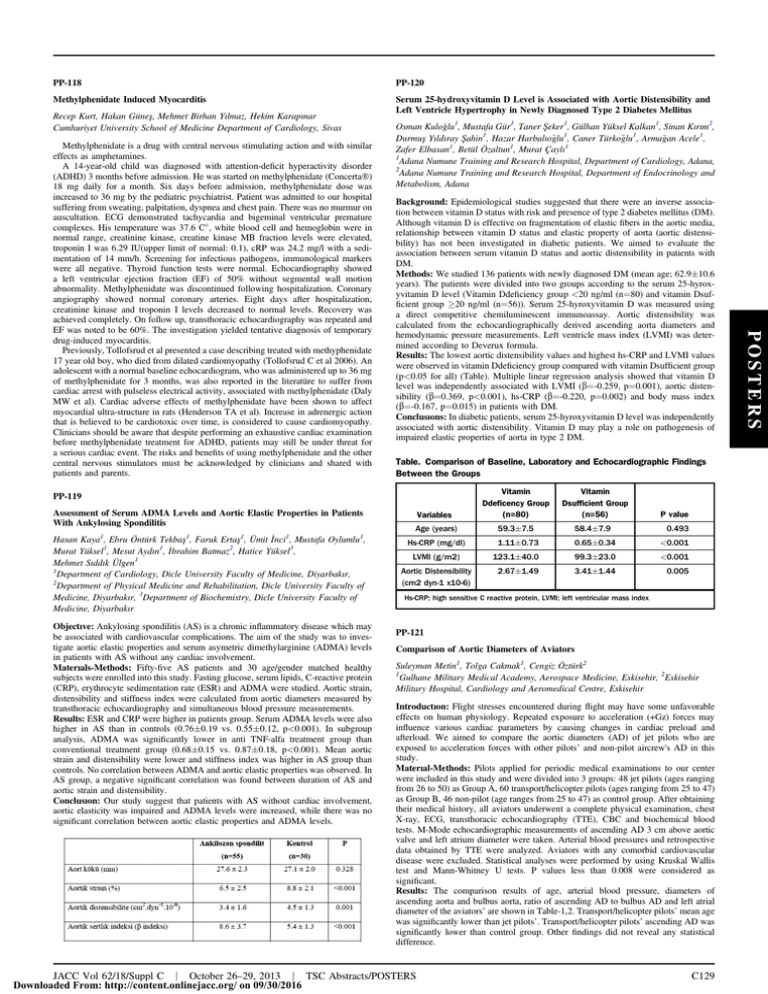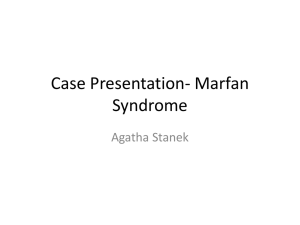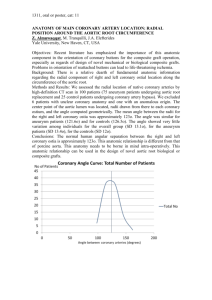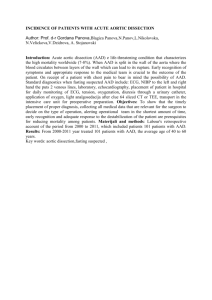Comparison of Aortic Diameters of Aviators
advertisement

PP-118 PP-120 Methylphenidate Induced Myocarditis Serum 25-hydroxyvitamin D Level is Associated with Aortic Distensibility and Left Ventricle Hypertrophy in Newly Diagnosed Type 2 Diabetes Mellitus Recep Kurt, Hakan Güneş, Mehmet Birhan Yılmaz, Hekim Karapınar Cumhuriyet University School of Medicine Department of Cardiology, Sivas Background: Epidemiological studies suggested that there were an inverse association between vitamin D status with risk and presence of type 2 diabetes mellitus (DM). Although vitamin D is effective on fragmentation of elastic fibers in the aortic media, relationship between vitamin D status and elastic property of aorta (aortic distensibility) has not been investigated in diabetic patients. We aimed to evaluate the association between serum vitamin D status and aortic distensibility in patients with DM. Methods: We studied 136 patients with newly diagnosed DM (mean age; 62.910.6 years). The patients were divided into two groups according to the serum 25-hyroxyvitamin D level (Vitamin Ddeficiency group <20 ng/ml (n¼80) and vitamin Dsufficient group 20 ng/ml (n¼56)). Serum 25-hyroxyvitamin D was measured using a direct competitive chemiluminescent immunoassay. Aortic distensibility was calculated from the echocardiographically derived ascending aorta diameters and hemodynamic pressure measurements. Left ventricle mass index (LVMI) was determined according to Deverux formula. Results: The lowest aortic distensibility values and highest hs-CRP and LVMI values were observed in vitamin Ddeficiency group compared with vitamin Dsufficient group (p<0.05 for all) (Table). Multiple linear regression analysis showed that vitamin D level was independently associated with LVMI (b¼-0.259, p¼0.001), aortic distensibility (b¼0.369, p<0.001), hs-CRP (b¼-0.220, p¼0.002) and body mass index (b¼-0.167, p¼0.015) in patients with DM. Conclusıons: In diabetic patients, serum 25-hyroxyvitamin D level was independently associated with aortic distensibility. Vitamin D may play a role on pathogenesis of impaired elastic properties of aorta in type 2 DM. Table. Comparison of Baseline, Laboratory and Echocardiographic Findings Between the Groups Variables Vitamin Ddeficency Group (n=80) Vitamin Dsufficient Group (n=56) Age (years) 59.37.5 58.47.9 Hs-CRP (mg/dl) 1.110.73 0.650.34 <0.001 LVMI (g/m2) 123.140.0 99.323.0 <0.001 Aortic Distensibility (cm2 dyn-1 x10-6) 2.671.49 3.411.44 0.005 PP-119 Assessment of Serum ADMA Levels and Aortic Elastic Properties in Patients With Ankylosing Spondilitis _ 1, Mustafa Oylumlu1, Hasan Kaya1, Ebru Öntürk Tekbaş1, Faruk Ertaş1, Ümit Inci _ Murat Yüksel1, Mesut Aydın1, Ibrahim Batmaz2, Hatice Yüksel3, Mehmet Sıddık Ülgen1 1 Department of Cardiology, Dicle University Faculty of Medicine, Diyarbakır, 2 Department of Physical Medicine and Rehabilitation, Dicle University Faculty of Medicine, Diyarbakır, 3Department of Biochemistry, Dicle University Faculty of Medicine, Diyarbakır Objectıve: Ankylosing spondilitis (AS) is a chronic inflammatory disease which may be associated with cardiovascular complications. The aim of the study was to investigate aortic elastic properties and serum asymetric dimethylarginine (ADMA) levels in patients with AS without any cardiac involvement. Materıals-Methods: Fifty-five AS patients and 30 age/gender matched healthy subjects were enrolled into this study. Fasting glucose, serum lipids, C-reactive protein (CRP), erythrocyte sedimentation rate (ESR) and ADMA were studied. Aortic strain, distensibility and stiffness index were calculated from aortic diameters measured by transthoracic echocardiography and simultaneous blood pressure measurements. Results: ESR and CRP were higher in patients group. Serum ADMA levels were also higher in AS than in controls (0.760.19 vs. 0.550.12, p<0.001). In subgroup analysis, ADMA was significantly lower in anti TNF-alfa treatment group than conventional treatment group (0.680.15 vs. 0.870.18, p<0.001). Mean aortic strain and distensibility were lower and stiffness index was higher in AS group than controls. No correlation between ADMA and aortic elastic properties was observed. In AS group, a negative significant correlation was found between duration of AS and aortic strain and distensibility. Conclusıon: Our study suggest that patients with AS without cardiac involvement, aortic elasticity was impaired and ADMA levels were increased, while there was no significant correlation between aortic elastic properties and ADMA levels. P value 0.493 Hs-CRP; high sensitive C reactive protein, LVMI; left ventricular mass index PP-121 Comparison of Aortic Diameters of Aviators Suleyman Metin1, Tolga Cakmak1, Cengiz Öztürk2 1 Gulhane Military Medical Academy, Aerospace Medicine, Eskisehir, 2Eskisehir Military Hospital, Cardiology and Aeromedical Centre, Eskisehir Introductıon: Flight stresses encountered during flight may have some unfavorable effects on human physiology. Repeated exposure to acceleration (+Gz) forces may influence various cardiac parameters by causing changes in cardiac preload and afterload. We aimed to compare the aortic diameters (AD) of jet pilots who are exposed to acceleration forces with other pilots’ and non-pilot aircrew's AD in this study. Materıal-Methods: Pilots applied for periodic medical examinations to our center were included in this study and were divided into 3 groups: 48 jet pilots (ages ranging from 26 to 50) as Group A, 60 transport/helicopter pilots (ages ranging from 25 to 47) as Group B, 46 non-pilot (age ranges from 25 to 47) as control group. After obtaining their medical history, all aviators underwent a complete physical examination, chest X-ray, ECG, transthoracic echocardiography (TTE), CBC and biochemical blood tests. M-Mode echocardiographic measurements of ascending AD 3 cm above aortic valve and left atrium diameter were taken. Arterial blood pressures and retrospective data obtained by TTE were analyzed. Aviators with any comorbid cardiovascular disease were excluded. Statistical analyses were performed by using Kruskal Wallis test and Mann-Whitney U tests. P values less than 0.008 were considered as significant. Results: The comparison results of age, arterial blood pressure, diameters of ascending aorta and bulbus aorta, ratio of ascending AD to bulbus AD and left atrial diameter of the aviators’ are shown in Table-1,2. Transport/helicopter pilots’ mean age was significantly lower than jet pilots’. Transport/helicopter pilots’ ascending AD was significantly lower than control group. Other findings did not reveal any statistical difference. JACC Vol 62/18/Suppl C j October 26–29, 2013 j TSC Abstracts/POSTERS Downloaded From: http://content.onlinejacc.org/ on 09/30/2016 C129 POSTERS Methylphenidate is a drug with central nervous stimulating action and with similar effects as amphetamines. A 14-year-old child was diagnosed with attention-deficit hyperactivity disorder (ADHD) 3 months before admission. He was started on methylphenidate (ConcertaÒ) 18 mg daily for a month. Six days before admission, methylphenidate dose was increased to 36 mg by the pediatric psychiatrist. Patient was admitted to our hospital suffering from sweating, palpitation, dyspnea and chest pain. There was no murmur on auscultation. ECG demonstrated tachycardia and bigeminal ventricular premature complexes. His temperature was 37.6 C , white blood cell and hemoglobin were in normal range, creatinine kinase, creatine kinase MB fraction levels were elevated, troponin I was 6.29 IU(upper limit of normal: 0.1), cRP was 24.2 mg/l with a sedimentation of 14 mm/h. Screening for infectious pathogens, immunological markers were all negative. Thyroid function tests were normal. Echocardiography showed a left ventricular ejection fraction (EF) of 50% without segmental wall motion abnormality. Methylphenidate was discontinued following hospitalization. Coronary angiography showed normal coronary arteries. Eight days after hospitalization, creatinine kinase and troponin I levels decreased to normal levels. Recovery was achieved completely. On follow up, transthoracic echocardiography was repeated and EF was noted to be 60%. The investigation yielded tentative diagnosis of temporary drug-induced myocarditis. Previously, Tollofsrud et al presented a case describing treated with methyphenidate 17 year old boy, who died from dilated cardiomyopathy (Tollofsrud C et al 2006). An adolescent with a normal baseline echocardiogram, who was administered up to 36 mg of methylphenidate for 3 months, was also reported in the literatüre to suffer from cardiac arrest with pulseless electrical activity, associated with methylphenidate (Daly MW et al). Cardiac adverse effects of methylphenidate have been shown to affect myocardial ultra-structure in rats (Henderson TA et al). Increase in adrenergic action that is believed to be cardiotoxic over time, is considered to cause cardiomyopathy. Clinicians should be aware that despite performing an exhaustive cardiac examination before methylphenidate treatment for ADHD, patients may still be under threat for a serious cardiac event. The risks and benefits of using methylphenidate and the other central nervous stimulators must be acknowledged by clinicians and shared with patients and parents. Osman Kuloglu1, Mustafa Gür1, Taner Şeker1, Gülhan Yüksel Kalkan1, Sinan Kırım2, Durmuş Yıldıray Şahin1, Hazar Harbalıoglu1, Caner Türkoglu1, Armagan Acele1, Zafer Elbasan1, Betül Özaltun1, Murat Çaylı1 1 Adana Numune Training and Research Hospital, Department of Cardiology, Adana, 2 Adana Numune Training and Research Hospital, Department of Endocrinology and Metabolism, Adana Conclusıon: Acceleration forces have some side effects on cardiovascular system in aviators besides hypoxia, radiation, aging, psychosocial stressors. In this study we investigated some cardiovascular parameters of jet pilots, transport/helicopter pilots and non-pilots and compared them via non-invasive studies. We found no difference between them. In other words, although pilots (especially high performance jet pilots) are exposed to much more stress factors, they do not carry more risk compared to general population in terms of cardiovascular diseases. Opposite to the expectations the ascending aorta diameters were lower in transport/helicopter pilots. Further studies with large groups are needed to define more clearly the correlation between flight stressors and cardiovascular parameters. Table 1 Parameters Group A P value 29 34,5 0,006 DAV (mm) 32,2 33,75 0,073 AAD (mm) 28,05 28,9 0,045 AAD/DAV 0,865 0,865 0,318 LAD (mm) 32,6 33,5 0,05 ABP systolic (mmHg) 115 120 0,825 ABP diastolic (mmHg) 80 80 0,834 POSTERS Age Group B Materıal-Method: We retrospectively evaluated the results of EST and presence of coronary artery pathology in 75 patients diagnosed as coronary artery disease by MSCT angiography (320 sliced) from a population of 7500 individuals. Results: Twelve subjects (16%, age 32.19.8) with 9 equivocal and 3 positive EST were diagnosed as normal coronary anatomy by MSCT. Of 63 (%84) patients; 19, 38 and 6 were diagnosed as coronary atherosclerosis (43.37.3), myocardial bridging (34.18.3) and co-existing coronary atherosclerosis and bridging (45.83.8), respectively. Positive predictive value of EST was as 84%. Conclusıon: EST is a valuable method for the evaluation of presence of coronary pathology either atherosclerosis or myocardial bridging in the era of MSCT angiography. So its utility could not be confined to subjects with older ages and high coronary risk profile. It is a convenient method and may effectively indicate the presence of any coronary pathology when used in co-operated with MSCT angiography. It is noteworthy that myocardial bridging is a disease of young and young adults which could potentially underlay the sudden cardiac death or cardiac events among young or middle aged population. Additionally equivocal EST should not be ignored in young subjects with low coronary risk profile especially who may expose to extremely strenuous physical activities due to occupational necessities. DAV(mm) = diameter of aortic valsalva, AAD(mm) = ascending aorta diameter, LAD(mm) = left atrial diameter, ABP(mm) = arterial blood pressure. Table 2 Parameters Group B Group C P Value Age 29 33,5 0,023 DAV (mm) 32,2 33,3 0,09 AAD (mm) 28,05 30,25 0,007 AAD/DAV 0,865 0,9 0,106 LAD 32,6 32,85 0,207 ABP systolic (mmHg) 115 115 0,359 ABP diastolic (mmhg) 80 70 0,365 PP-123 Assessment of Left Ventricular Mechanics Using Speckle Tracking Echocardiography in Patients with Subclinic Hypothyroidism DAV(mm) = diameter of aortic valsalva, AAD(mm) = ascending aorta diameter, LAD(mm) = left atrial diameter, ABP(mm) = arterial blood pressure. Table 3 Parameters Group A Group C P Value Age 34,5 33,5 0,469 DAV (mm) 33,75 33,3 0,895 AAD (mm) 28,9 30,25 0,558 AAD/DAV 0,865 0,9 0,694 LAD 33,5 32,85 0,525 ABP systolic (mmHg) 120 115 0,295 ABP diastolic (mmhg) 80 70 0,3 DAV(mm) = diameter of aortic valsalva, AAD(mm) = ascending aorta diameter, LAD(mm) = left atrial diameter, ABP(mm) = arterial blood pressure. PP-122 Higher Predictivity of Exercise Stress Test Contradictory to Bayes Theory in Young and Young Adults with Low Profile of Coronary Risk Mustafa Aparci1, Murat Yalcin2, Zafer Isilak2, Cengiz Ozturk3, Omer Uz2, Ugur Bozlar4, Ejder Kardesoglu2 1 Etimesgut Military Hospital, Department of Cardiology and Aviation Medicine, Ankara, 2Haydarpasa Training Hospital, Department of Cardiology, Istanbul, 3 Eskişehir Military Hospital, Department of Cardiology and Aviation Medicine, Eskisehir, 4Gulhane Military Medical Faculty, Department of Radiology, Ankara Aim: Bayes theory propose that predictivity of exercise stress test (EST) increases as the subjects get older and higher risk profile of coronary risk and vice versa. In the era in which coronary imaging was dependent on invasive methods and contrast media revealing negative luminal irregularities and indentation that theory has validity. However extraluminally placed atherosclerotic plaque at initial stage or myocardial bridging which could not produce intraluminal filling defect may be reported as normal coronary artery anatomy in patients with positive or equivocal exercise stress test. Thus positive predictivity of EST was accepted as highly lower in young or young adults with low profile of coronary risk. In this study we aimed to retrospectively evaluate the role of EST in documenting coronary pathology of subjects diagnosed with MSCT angiography. C130 Downloaded From: http://content.onlinejacc.org/ on 09/30/2016 Yasemin Kaya1, Havva Keskin2, Kamuran Kalkan3, Selim Topçu3, _ Ibrahim Halil Tanboga3, Ahmet Kaya4, Enbiya Aksakal3 1 Department of Internal Medicine, Ordu University Faculty of Medicine, Ordu, 2 Department of Internal Medicine, Erzurum Education and Resarch Hospital, Erzurum, 3Department of Cardiology, Atatürk Universtiy Faculty of Medicine, Erzurum, 4Department of Cardiology, Ordu University Faculty of Medicine, Ordu Objectıves: The association between subclinic hypothyroidism (SH) and cardiac functions has been identified in recent studies. In this study we aimed to examine the cardiac functions with 2D speckle tracking echocardiography (STE) in patient who had SH. Study Design: Twenty-five patients (21 women and 4 men) with newly diagnosed SH compared with 23 age- and sex-matched healthy subjects (19 women, 4 men) were evaluated by STE. The diagnosis of SH was based on increased serum thyroid stimulating hormone (TSH) level in the presence of normal free T3 and free T4 levels. For all patients, we evaluated cardiac mechanic functions with STE. Results: The SH group consisted of 25 patients whose mean age 399.4 years and in control group there was 23 healthy subjects whose mean age 387.9 years. There was no difference between groups in regarding mitral inflow E, A wave and E/A ratio, whereas mitral deceleration time was shorter in the SH group (p¼0.03). Besides, SH patients had shorter E` wave velocity (p:0,02) and higher E/E`ratio (p¼0.01). When compared to the control group, left ventricle longitudinal strain values (left ventricleglobal strain, left ventricle 4 chamber and left ventricle 2 chamber) were lower in the SH patients (for left ventricle-global strain 17.3+2.2 vs 19.1+2.1, p¼0.002). But there was no differences apical rotation, basal rotation and twist between two group. Conclusıon: Our data suggest that SH is associated with impaired left ventricular longitudinal mechanics but not with rotational mechanics. PP-124 Neutrophil/Lymphocyte Ratio May Predict in-Hospital Clinical Events in Patients with Aortic Dissection Süleyman Karakoyun, Mustafa Ozan Gürsoy, Lütfi Öcal, Macit Kalçık, Mahmut Yesin, Emrah Erdogan, Şeyhmus Külahçıoglu, Ruken Bengi Bakal, Cengiz Köksal, Mustafa Yıldız, Mehmet Özkan _ _ Kartal Koşuyolu Yüksek Ihtisas Egitim ve Araştırma Hastanesi, Istanbul Introductıon: Inflammation has been reported to be associated with aortic dissection, from the development to prognosis of aortic dissection. Neutrophil/lymphocyte ratio (NLR) is a novel inflammatory marker of prognosis in patients with cardiovascular disease. In this study we aimed to seek the role of neutrophil/lymphocyte ratio in prediction of clinical events in patients with acute aortic dissection. Methods: The study was comprised of 47 patients who was hospitalized at our center between 2010 and 2013 with diagnosis of acute aortic dissection. The variations of NLR were analyzed between patients with events and without events in this retrospective monocentric study. NLR was calculated using data obtained from the complete blood count. Multivariate analysis was performed for the predictors of JACC Vol 62/18/Suppl C j October 26–29, 2013 j TSC Abstracts/POSTERS







